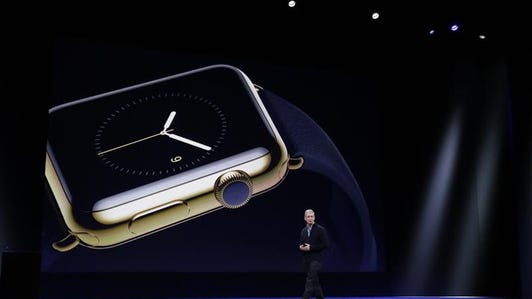
James Martin/CNET
Just how jolly was Apple’s holiday quarter? If the latest Wall Street estimates are accurate, the answer is “very.”
When it comes to the consumer electronics giant’s financials, all eyes will be on the iPhone. The Cupertino, Calif., company generates more than half its revenue from its smartphone business, and the fiscal first quarter, which ends in December, is typically Apple’s biggest quarter of the year because of holiday sales and the recent introduction of the latest iPhones.
This year’s first quarter marked Apple’s first full period of 4.7-inch iPhone 6 and 5.5-inch 6 Plus sales, which could result in higher revenue and profits than ever before. (The last record quarter for sales was 2014’s fiscal first quarter with revenue of $57.6 billion.) Apple said it sold more units at launch than any previous iPhone model, and it’s likely demand didn’t slow down in the following months.
Apple is believed to have sold 66.5 million iPhones in the period, according to an analyst poll by Fortune. That’s nearly a third more devices than the record 51 million sold in the year-earlier quarter.
“Indications are that the new large iPhones produced a better-than-expected quarter, offsetting any weakness in iPads,” noted Janney Capital Markets analyst Bill Choi.
See also
- iPhone 6 promises happy holidays for Apple
- iPhone 6, iPhone 6 Plus may be tough to find through the holidays
- CNET’s initial thoughts on the Apple Watch
The company will release its most recent financial results Tuesday. Apple didn’t respond to a request for comment ahead of the report.
CEO Tim Cook will also likely give information about whether Apple is now making enough iPhones to meet the demand for the devices. In October, he said iPhone 6 and 6 Plus demand was and it could stay that way through the end of the calendar year. Some analysts believe Apple still isn’t making enough iPhones.
“Our checks indicate that demand-supply for iPhone 6 and 6 Plus is tighter than the last two generations, which bodes well for better-than-expected [fiscal first-quarter] results and [fiscal second-quarter] guidance,” noted Oppenheimer analyst Andrew Uerkwitz.
Overall, analysts expect the company to report revenue of $67.5 billion, net income of $15.3 billion and per-share earnings of $2.59, according to a poll by Thomson Reuters. Apple in October had projected first-quarter revenue of $63.5 billion to $66.5 billion, which topped expectations at the time.
The iPad question
While Apple’s smartphone sales have been soaring, iPad sales have been floundering. Large-screen smartphones, including the iPhone 6 Plus, are eating away at the need for a tablet, and consumers have held on to their iPads longer than their smartphones. Apple has been facing questions for months over whether the iPad’s declining shipments are a temporary hiccup or a troubling trend.
This quarter’s results could be telling. The iPad tends to have strong sales in the December quarter as consumers scoop them up for holiday gifts. Apple posted its biggest period ever in fiscal 2013’s holiday quarter, with sales of 26 million iPads. However, iPad demand has fallen every quarter since then, and first quarter 2013 was one of only three quarters out of the past eight that iPad unit sales and revenue rose year over year. In Apple’s fiscal fourth quarter, which ended September 27, iPad unit sales dropped 13 percent to 12.3 million units.


Now playing:
Watch this:
iPhone 6 launch mania in NY: Bigger phones, bigger lines
3:00
The company introduced its newest tablets — the iPad Air 2 and the iPad Mini 3 — in October, but analysts say the incremental changes likely aren’t enough to attract buyers in droves. They predict Apple sold 21.5 million iPads in the fiscal first quarter, according to a poll by Fortune, down 17 percent from the year-ago period.
“Demand for newer iPad models appears weak,” noted UBS analyst Steven Milunovich. He said about 20 percent of iPads sold in the December quarter likely were the older iPad with Retina, not the new iPad Air 2.
Apple, for its part, has called the iPad’s weakness “a speed bump.”
Apple Watch time?
What people are really hoping to hear from Apple’s earnings call, though, is what’s happening with Apple Watch. The company hasn’t yet revealed when it will start selling its first smartwatch aside from saying “early 2015.” And Apple hasn’t shared more details about the wearable, such as pricing for its higher-end models, since announcing the device in September.
Apple Watch is the first major new product category for the company since the “magical” iPad in 2010. It’s also the first new push by the company under Cook’s tenure. Cook had promised for over a year that Apple in 2014 would introduce and enter beyond its wildly successful smartphones, tablets and computers. The Apple Watch, along with the new Apple Pay mobile payments service, fulfill that vow.
Apple Watch keeps up with the times (pictures)






Cook likely won’t provide much — if any — information about Apple Watch during the earnings call. Apple tends to save product information for flashy press events, not financial reports. Still, that hasn’t stopped analysts from making their projections for Apple Watch sales. Morgan Stanley analyst Katy Huberty expects Apple to sell about 30 million smartwatches this calendar year.
“iPhone users are twice as likely to purchase wearables compared to other smartphone users, and they overwhelmingly pick Apple’s Watch, suggesting a strong ‘halo effect,'” she noted.
We are also likely to hear about how emerging markets have been performing and whether Mac sales have remained strong. Apple also could talk about plans to return even more cash to shareholders.
Tune back in to CNET for full coverage of Apple’s financial report on Tuesday.



